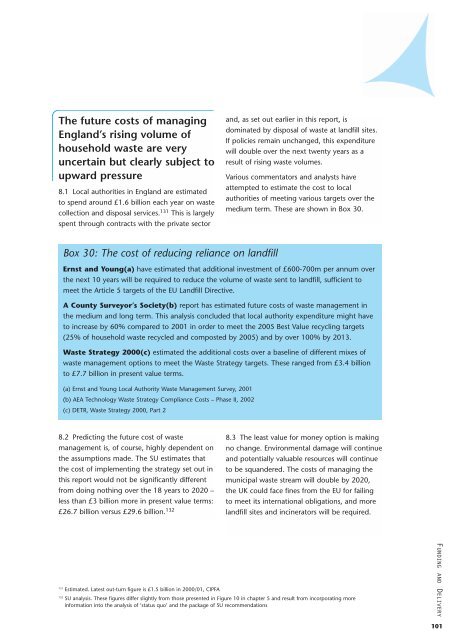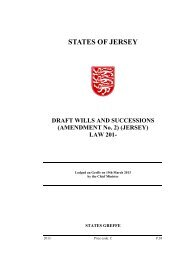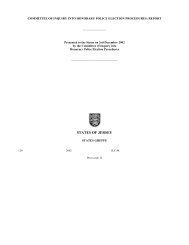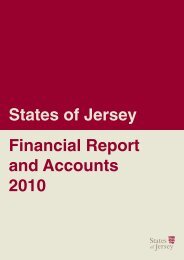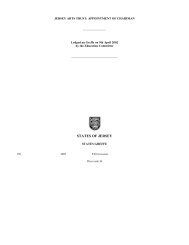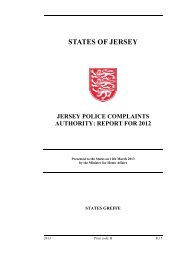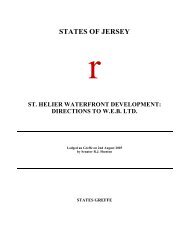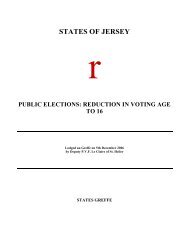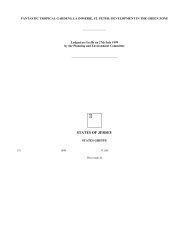Waste not want not - States Assembly
Waste not want not - States Assembly
Waste not want not - States Assembly
Create successful ePaper yourself
Turn your PDF publications into a flip-book with our unique Google optimized e-Paper software.
The future costs of managing<br />
England’s rising volume of<br />
household waste are very<br />
uncertain but clearly subject to<br />
upward pressure<br />
8.1 Local authorities in England are estimated<br />
to spend around £1.6 billion each year on waste<br />
collection and disposal services. 131 This is largely<br />
spent through contracts with the private sector<br />
and, as set out earlier in this report, is<br />
dominated by disposal of waste at landfill sites.<br />
If policies remain unchanged, this expenditure<br />
will double over the next twenty years as a<br />
result of rising waste volumes.<br />
Various commentators and analysts have<br />
attempted to estimate the cost to local<br />
authorities of meeting various targets over the<br />
medium term. These are shown in Box 30.<br />
Box 30: The cost of reducing reliance on landfill<br />
Ernst and Young(a) have estimated that additional investment of £600-700m per annum over<br />
the next 10 years will be required to reduce the volume of waste sent to landfill, sufficient to<br />
meet the Article 5 targets of the EU Landfill Directive.<br />
A County Surveyor’s Society(b) report has estimated future costs of waste management in<br />
the medium and long term. This analysis concluded that local authority expenditure might have<br />
to increase by 60% compared to 2001 in order to meet the 2005 Best Value recycling targets<br />
(25% of household waste recycled and composted by 2005) and by over 100% by 2013.<br />
<strong>Waste</strong> Strategy 2000(c) estimated the additional costs over a baseline of different mixes of<br />
waste management options to meet the <strong>Waste</strong> Strategy targets. These ranged from £3.4 billion<br />
to £7.7 billion in present value terms.<br />
(a) Ernst and Young Local Authority <strong>Waste</strong> Management Survey, 2001<br />
(b) AEA Technology <strong>Waste</strong> Strategy Compliance Costs – Phase II, 2002<br />
(c) DETR, <strong>Waste</strong> Strategy 2000, Part 2<br />
8.2 Predicting the future cost of waste<br />
8.3 The least value for money option is making<br />
management is, of course, highly dependent on no change. Environmental damage will continue<br />
the assumptions made. The SU estimates that and potentially valuable resources will continue<br />
the cost of implementing the strategy set out in to be squandered. The costs of managing the<br />
this report would <strong>not</strong> be significantly different municipal waste stream will double by 2020,<br />
from doing <strong>not</strong>hing over the 18 years to 2020 – the UK could face fines from the EU for failing<br />
less than £3 billion more in present value terms: to meet its international obligations, and more<br />
£26.7 billion versus £29.6 billion. 132 landfill sites and incinerators will be required.<br />
131<br />
Estimated. Latest out-turn figure is £1.5 billion in 2000/01, CIPFA<br />
132<br />
SU analysis. These figures differ slightly from those presented in Figure 10 in chapter 5 and result from incorporating more<br />
information into the analysis of ‘status quo’ and the package of SU recommendations<br />
FUNDING AND DELIVERY<br />
101


